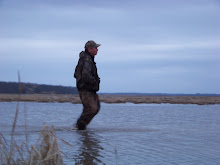"Etchings"
 Chances are, if you’re reading this, you have an affinity for outdoor pursuits. As such, you probably appreciate sporting and wildlife art, just as I do. In fact your wife, like mine, probably gave up trying to keep the steady stream of duck, dog and turkey prints that inevitably accompany you home from DU and NWTF banquets off the walls years ago (“You’d better not come home with any more hunting prints!”). Mine was successful in halting their advance after she lost just one room in our home, which she now bitterly refers to as the “man room.”
Chances are, if you’re reading this, you have an affinity for outdoor pursuits. As such, you probably appreciate sporting and wildlife art, just as I do. In fact your wife, like mine, probably gave up trying to keep the steady stream of duck, dog and turkey prints that inevitably accompany you home from DU and NWTF banquets off the walls years ago (“You’d better not come home with any more hunting prints!”). Mine was successful in halting their advance after she lost just one room in our home, which she now bitterly refers to as the “man room.”Being the discerning sportsman that you are, you’re probably familiar with the sporting art of Brett James Smith. If you aren’t, you should be. His paintings (I can afford only prints) are not only lifelike, but take on a personal, introspective feel. One of his more famous works which you’ve probably seen hanging in a deer camp or your dentist’s office is a painting entitled Bad Angle Buck, II, which depicts a hapless hunter in an elevated blind watching the buck of a lifetime escape from behind the hunter’s off-shoulder. Smith’s duck hunting and upland bird paintings are nothing short of brilliant also.
In addition to his paintings, Smith has assembled a prolific collection of outdoor etchings. In fact, Smith is arguably as well known for his etchings as he is his paintings. I marvel at how his small, mostly two-toned etchings capture so much action, fluidity and feeling. Yet they exude the shared emotions of outdoorsmen in a subtle, quiet manner at the same time.
I have long wondered where Smith gets the inspiration for his etchings. Do they depict his personal experiences, those of his friends’ or simply his imagination?
Suffice it to say I will never be the subject of one of Mr. Smith’s collectible etchings or water colors. He won’t be releasing any future works showcasing me with my Parker side-by-side leading a low, crossing dove just right, or flushing a covey of quail over a world champion German shorthair.
I don’t think there’s much of a market for an etching depicting a frantic fisherman, alone in a Lund aluminum boat on glacier lake in Canada, a hundred yards from shore, desperately trying to outrace the surge of 55-degree water which is pouring in over the transom. I’m not sure how the etching would illustrate the top of the motor just beneath the surface of the water, or the panic on the pilot’s face, but such detail would certainly add drama to the piece. It could be called Don’t Try To Run Water Out Of A Boat When You Don’t Know What You’re Doing Or You Might Sink The Boat And Drown In A Nameless Lake 1,600 Miles From Home. Luckily, the guy made it ashore and lived to write about it.
There’s not too much understated romanticism in the image of a deer hunter crawling around on his hands and knees scouring the leaves for a blood trail. So that might not work for an etching, either. Nor would a rendition of a duck hunter sitting in a blind trying to get mud out of the muzzle of his shotgun while his buddies – who know how to walk across a rice field levee without toppling forward into the muck – take down a few drake mallards.
What about the lonely image of a stubborn Labrador retriever walking thirty feet in front of his “master” and going about his business as he pleases, entirely indifferent to the repeated grunts of, “Heel! Stay!” and “Bad dog!”?
Or consider the heart-wrenching scene where a less-than-modestly successful turkey hunter has just called up a mature gobbler to within thirty-or-so steps, at which point the bird strutted and gobbled and put on a real show, before the hunter – his heart and his memory overflowing with the pageantry of the spectacle – pulls the trigger and walks over to the flopping bird. Only to have the bird get up and run off through the briars just when the hunter bends down to pick it up by its feet! How does an etching’s metal and acid and ink capture that heartbreak? I’m not sure whether an etching is capable of communicating such pain but if anyone has the talent to do so, it’s Mr. Smith.
The possibilities are endless I suppose. The shorthaired pointer’s backward glance full of incredulity and scorn at the hunter who can’t seem to hit the broad side of a barn. The turkey hunter who has spent all morning pursuing a gobbling tom, right up to a property line; added emphasis could be placed by showing the strutting tom out in the open on the other side. The splash of water created by a seven-pound bass plummeting back to safety after wriggling free from the astonished fisherman’s hook.
Outdoor communicators, whether we be artists or writers, rely heavily on our personal experiences for inspiration. Thankfully for Mr. Smith and his fans, he clearly doesn’t get his inspiration from the likes of me.
(c) Roger Guilian 2010


<< Home